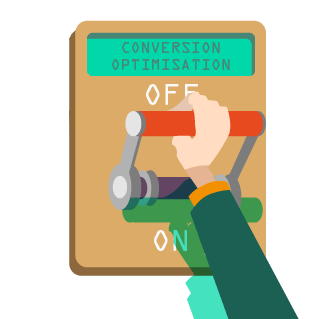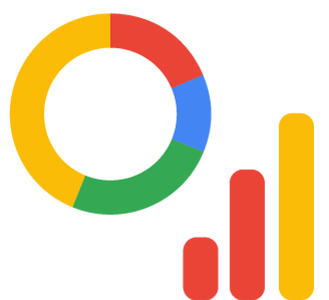What is conversion optimisation?
Well, have you ever found yourself with lots of pageviews, but little to no change in leads or sales? You’re not alone.
Drawing traffic to your website through your content marketing efforts is only one half of the equation when it comes to growing your business online.
Once you’ve got that traffic through your (virtual) door, you need to keep it there. How else will you convert that traffic into paying customers?

And once they’ve made their first purchase, you then want to transform them into loyal buyers. The kind who will return again and again to make use of your products or services.
This is where conversion optimisation comes in.
Conversion rate optimisation (CRO) is all about increasing the number of site visitors who take a desired action. Conversion Optimisation helps you to understand and improve how users navigate through your website.
What is Conversion Rate?
A ‘conversion’ is the name given for when site visitors complete goals on your website.
Lots of people think of conversions in relation to making sales, which isn’t surprising. Making sales is usually what lies at the heart of most companies’ goals – also known as macro-conversions.
But there are also smaller conversions (micro conversions) that can happen before a visitor makes a purchase. Such as signing up to your newsletter, or creating an account on your site.
In order to know if your goals are successful, you need to understand how many people are coming through the sales funnel and carrying out the necessary actions.
And to evaluate this, we look at your conversion rate.
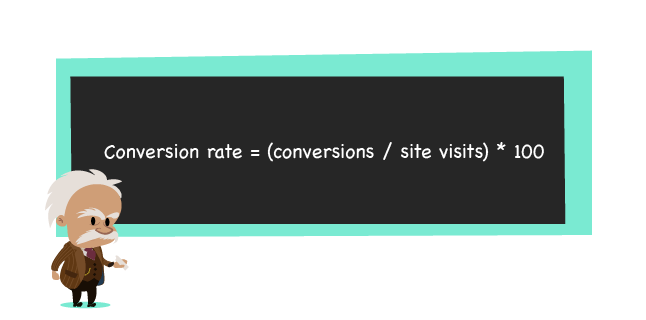
Your conversion rate is the number of times a user completes one of your goals divided by your site traffic.
Conversion rate = (conversions / site visits) * 100
Calculating your site’s conversion rate is very easy to do. It also gives you a greater understanding as to how your website is currently performing. In addition, it’s also a great way to measure the impact of your marketing efforts.
What is Conversion Rate Optimisation?
Conversion rate optimisation (CRO) is the process of improving the user experience on your website. The intent of CRO is to increase the percentage of visitors who take a desired action. For instance, actions such as completing a purchase, filling in a form, or downloading a brochure.
Conversion optimisation, as a process involves understanding three main things:
- How users navigate through your website
- The site actions they take
- What’s stopping them from completing your goals
Once you have decided which area of your site you need to improve on, you then implement the necessary changes. You can then test these against your current version to see which is more effective.
In the end, you permanently implement the variation which converts the highest percentage of people to complete your desired action.
Conversion optimisation doesn’t have to mean huge changes
It may come as a surprise that there are many different things that affect your conversion success.

For instance, your website copy, layout, image selection and even fonts can have a huge impact. These factors can determine the number of people who subscribe to your newsletter or buy one of your products.
In fact, in a test run by a company named Performable, they found that simply changing the colour of the ‘get started now’ button on their homepage from green to red led to a 21% rise in click-through rates (CTR).
Results like this highlight why conversion rate optimisation is so valuable for your company. Because even the smallest of changes can have a significant impact.
Testing is key
When it comes to conversion rate optimisation, testing is a key factor.
Without it, you’re left to trust your gut instinct to determine what will be more effective. And that’s never a wise route to take. However, when you use testing, you eliminate the guesswork. As such, you’ll always know what area of your site to improve on.
There are endless tests you can run on your site. You can trial different headings, button colours, call-to-action copy and much more. Each change has the opportunity to impact conversions, so all are vitally important.
And, with the power of A/B testing, you can set up two variations of a web page. Then, split the traffic that arrives at each. This makes it easier to assess which one is performing better, without having to trial one at a time.
5 Benefits of Conversion Rate Optimisation
The benefits of improving your conversion rate through conversion optimisation are practically limitless. There’s no excuse for you to not be doing it. Especially when you can improve the number of people visiting your site and becoming paying customers.
But other than driving more revenue for your brand, there are 5 additional benefits to optimising your conversion rate.
1. Improved customer lifetime value

Your customer lifetime value (CLV) is the total worth of a customer to a business. As the name suggests, it’s measured over the entire period of their relationship with you.
And the better your conversion rate, the better your customer lifetime value. As you optimise the user experience you’ll encourage more of your customers to come back and make future purchases. As a result, this will increase the amount of money they’ll spend with you.
You’ll be able to reduce your spend on acquiring new customers. So you can maximise opportunities with your existing base.
2. Improved SEO
Conversion rate optimisation is all about improving the user experience. And so is SEO. The two go hand-in-hand.
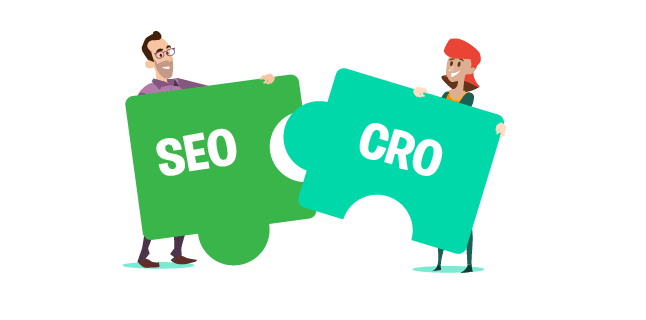
If you can optimise your site to better suit your audience’s preferences, the more they’re going to return. And, the longer they’re going to spend their time on it.
Search engines will then infer these actions and may rank your pages higher because of them. Especially if they’re deemed relevant to the searcher’s query.
Too often, marketers can be single-minded. They try to use content marketing and SEO as a way of driving more traffic and making more sales. But, with the customer-centric approach that conversion rate optimisation demands, it’s a great way of reminding them to shift focus. Conversion optimisation nudges their efforts towards improving the user experience.
Anything you can do to better align your site to your customer’s needs will benefit your SEO. With CRO, you’ll be encouraging your users to stick around, adding value to how search engines infer your pages.
3. Refining your audience
The process of optimisation allows you to get a better understanding of your users. Both in theory, and in practice (as you test your hypotheses).
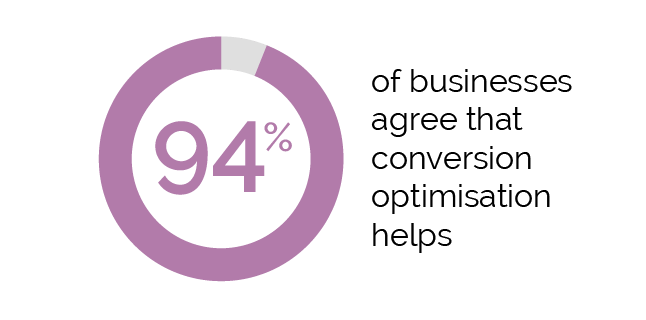
In fact, 94% of businesses agree that conversion optimisation helps them to gain a deeper understanding of their audience. It also helps them to build empathy with their audience.
The more you hypothesise, test and implement changes on your site, the more you’ll learn about your audience. This even includes their likes and dislikes, making it easier to market specifically in line with their wants and needs.
There are plenty of intangibles that come with a better understanding of your site visitors, targeted marketing is one of them. It surrounds a particular behaviour, query or type of visitor.
And it makes sense. The more insights you have about your audience, the better marketing opportunities you have. Whether you’re trying to build a connection with them or attempting to entice them back to your site.
4. Better return on investment (ROI)
The process of optimising your conversions can help you to get a better return on investment – whether time or money.
As you analyse and improve your customer retention rate, you’ll be getting more conversions without having to put in more work later down the line.

This will be a better return on your investment. Because the initial energy you put into improving your website will have long-lasting impacts and continue to drive conversions.
Some of your initial changes may not even need to be that big. You’ll be able get some easy results with little to no investment. For example, you may find changing your call-to-action from ‘get the insights’ to ‘subscribe to our newsletter’ could take your newsletter subscription rate through the roof.
5. Enhanced trust
In today’s digital world, trust is like currency. Without it, your website is useless.
For a visitor to share their card details, email or other personal information, they need to trust in your brand. And that comes down to your website.

Think of your website like a 24/7 digital store assistant. Like a real salesperson, your website should be professional, easy-to-understand and have information ready to answer your prospective customers’ questions.
By optimising your site and making it easier for your site users to navigate, you’ll be building trusted connections. Which, over time will make enticing them into the sales process much easier.
Successfully Optimising your Website
In order to optimise your conversions, you need to understand what to optimise and who for.
This means gathering the right data in order to make informed tweaks to your website.
Two main types of data used to review and optimise your site include:
- Quantitative data
- Qualitative data
Both are very different. one focuses on the use of raw data, while the other takes value in speaking directly to your audiences. The two can be used in conjunction with one another for maximum effect.
Together they can provide an enriched, detailed analysis of your customer’s behaviour. One which is filled with honest, open feedback and backed by genuine data.
1. Quantitative data analysis
This method involves your analytics data. It provides you with the hard numbers behind how your customers actually behave on your site.
Using the free Analytics tool from Google, you’ll be able to add tracking to your pages (small pieces of code).
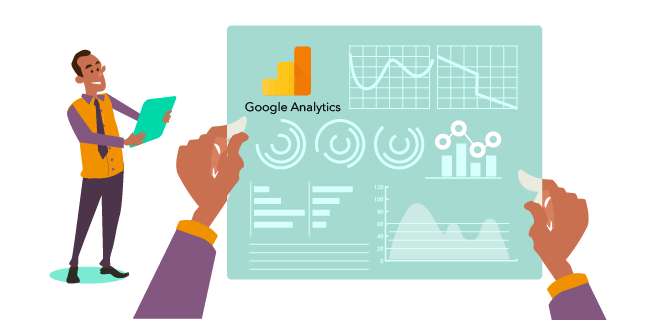
For example, if a user arrives on your homepage but exits on your ‘/order-complete’ page, you could add the code here. That way, you can track the number of customers who are completing their purchases on your website.
Similarly, you might add code to the ‘thank you for subscribing to our newsletter’ page. From here, you’ll be able to track how many site visitors are submitting their details into the email subscription form.
Adding tracking code to your website is very easy to do. It will allow you to see your current conversion rate but also monitor the effects of your future optimisation work.
Once you’ve added your tracking to your conversion pages, you can use the other metrics Analytics offers to see how your visitors are actually engaging with your site.
You’ll have access to information such as:
- Which are your most popular landing pages
- How long they spend on your website
- What channel brought them to your site (e.g. SEO, social media, email).
- Who your customers are
- Where they abandon the sales funnel (which page or activity makes them leave your site)
- (For product sales) which pages they’re making most of their purchases from
From here, you can start to hypothesise and evaluate where to focus your efforts next.
For example, if you see lots of people abandoning your website on a particular product page, focus your attention there. You may notice spelling errors or choose to add more copy to the page. Perhaps you could even add video content demonstrating the product in use.
Whatever it is you experiment with, by putting your effort into the pages which suffer the largest exit rate, the more impact you’ll see from your optimisation.
2. Qualitative data analysis
Although a quantitative analysis helps you to see from a numbers perspective where to focus energy, it doesn’t explain why. It can’t give you an exact reason as to why people aren’t converting into customers.

By conducting a qualitative data analysis, you can take your data, and identify who you need to speak to. Then, you can reach out to your customers with surveys and user-testing to learn about their engagement with your website.
You can find out information such as:
- What drew them to your website
- What they did and didn’t enjoy about their experience
- How they perceive you to be different from your competitors
- If they could make changes, what would they be
Obviously, you can’t ask every single visitor to take part in your surveys. And you’ll never be able to create a website that perfectly matches every individuals’ preferences. But, by taking the most commonly raised points and introducing the necessary edits, you’ll be improving your overall user experience.
Summary
Growing your business online can be split into two parts. First is the process of driving new traffic to your website. Second, is your attempt to convert them into loyal, paying customers.
Conversion optimisation focuses on taking this new traffic then making relevant tweaks to your website. These tweaks are implemented to encourage site visitors to take a desired action. Such as purchase a product or sign up to your newsletter.
This conversion process requires a customer-centric approach. You need to understand what on your website isn’t working for your audience. Only then can you evaluate what you need to do differently to encourage them to convert.
Optimising your website for conversions has an indispensable number of benefits. Aside from the obvious – growing revenue and maintaining a loyal customer base – you can enjoy improved SEO rankings. As well as better customer lifetime value and an enhanced return on your investments.
When it comes to optimising conversion rates, there are two ways you can go about understanding customer behaviours and traffic. This is through quantitative and qualitative data analysis.
With raw data and rich detailed customer responses, you’ll be able to best implement changes. Rather than guessing what needs to change, conversion optimisation is a great tool for knowing what actions to take. Start taking the right actions for your site, the ones needed to improve user experience and drive your conversions up.
Working With a Marketing Consultant to Optimise your Conversions
As appealing as conversion rate optimisation is, it can be very demanding of your time and resources. It can take a long time to analyse and theorise your data. And this is before you’ve spent time implementing the changes. Not to mention, then waiting to see if they’ve had any impact.
On top of this, many small or new start-up businesses may decide to work on their CRO on top of their content marketing and SEO strategy in order to draw new leads in. Something which can be near impossible to balance if you want to do it successfully.
This is where you may look to work with a marketing consultant such as myself.
Whether you need advice on how to best optimise your site, or need someone to take control of your entire SEO and customer acquisition process, we can help. My team and I can create a bespoke plan that’s tailored to your website’s wants and needs.
To find out more about the services we offer, please arrange a call with me. I’d love to speak to you and hear more about your brand. I’ll also walk you through some examples of how we’ve helped clients in the past.
